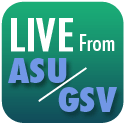Teachers at Summit Tell Ed. Companies What They Want–and What They Don’t
Scottsdale, Ariz.
Many of the attendees at the ASU/GSV summit being held here this week are operating in the same orbit—a competitive space in which companies are scrambling to find out what ed-tech products schools want, and then convince K-12 officials that their products are the ones they need to buy.
The speakers at one panel during the conference were able to offer companies some insights, often in very blunt terms. The panelists included a pair of teachers, who spoke about their hopes for classroom technology, and their disappointments about what it doesn’t deliver.
 Tanesha Dixon, a middle school social studies teacher, said that many of the classroom technologies she saw didn’t seem as if they’d been designed to make educators’ lives easier, and would most likely add to their workload.
Tanesha Dixon, a middle school social studies teacher, said that many of the classroom technologies she saw didn’t seem as if they’d been designed to make educators’ lives easier, and would most likely add to their workload.
The teacher at the Wheatley Education Campus, a public school in the District of Columbia, said she wasn’t convinced that developers were doing enough to seek out the opinions of educators.
“I always wonder, how do you develop a product?” Dixon asked the audience. “Are you sitting at home in your basement?…I feel like no one’s talking to us.”
Dixon says decisions about which technology she uses are largely made at the district level. In some cases, she’s impressed by the tools that come her way. She’s a fan of a Discovery Education “Techbook” tool, which she says helps her easily shift between lessons for students at grade level and below it, and between student who are fluent in English, and others who are Spanish speakers.
The panel was held to coincide, and in some ways reinforce, the message conveyed in a report released this week by the Bill & Melinda Gates Foundation, which surveyed teachers nationwide on their tech needs. Among its findings: educators believe only about half of the digital tools their students are using are effective, and teachers say the value of those tools varies widely by grade level and subject.
ASU/GSV officials said they’ve made an effort to create more opportunities at the conference for developers and companies to hear directly from teachers. Many product developers would probably counter Dixon’s points by saying that it’s difficult for them to get access to schools to conduct research on what works for teachers. Districts are often reluctant to grant that access, sometimes because they don’t want to be perceived as allowing companies to test out digital tools, of questionable quality, on students.
Another teacher on the panel, Arelys Villeda, an elementary teacher in the Chicago schools, said she wished more education products were developed with students’ lack of background in some forms of technology in mind. Despite all the talk about students being digital natives, Villeda noted that it still takes time for students to grow accustomed to new digital tools, particularly because not all students have the same access to technology.
“Before they get to the technology, they need to learn the technology,” she said. Some of them “don’t have it at home.”
Villeda also made a pitch for developers to think about making products that promote shared learning opportunities, not simply having students sitting in isolation, wearing headphones as they go through tech-based tasks.
Like Dixon, she urged developers to “reach out…ask us questions,” and reminded them, “it’s been a long time since you were a student.”
Some developers appeared to take her at her word: After the session ended, Dixon and Villeda were cornered by several audience members wanting their input.
Photo: D.C. middle school teacher Tanesha Dixon speaks with an attendee of the ASU/GSV conference, after her panel discussion.
